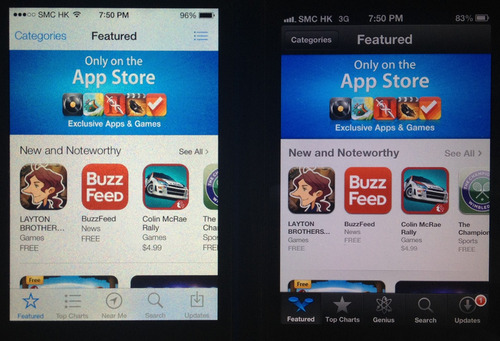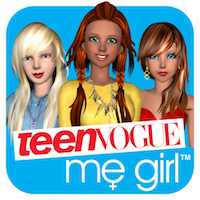Game Live Ops (slides from Casual Connect)
It was fun to talk about live operations, specifically time limited* content and mechanics, at this year’s .
I’ve uploaded my slides here, which cover:
- The different types of live ops
- Why game developers should care?
- Some industry examples, including one of our own
- Lessons learned
* new levels and missions etc also falls under the topic of live ops but the slides focussed in on time limited content.
The talk itself was only 20 minutes which was a shame as it’s a fascinating topic and lots of interesting things to go into (eg- pros and cons of different contest mechanics etc)
Any great examples of live ops out there? Share on or
How iOS 7 appstore changes affect developers
New iOS, new App Store…
If you’re like me, it’s time for optimism with a touch of dread. Are the changes better or worse for my apps? My players?
Recently checked out the Appstore in iOS 7 vs iOS 6. Overall it’s a step forward and imho mostly positive for devs. Here are the side-by-side iPhone screenshots. Recommendations at the end.
Featured Page

- More new and noteworthy spots shown before requiring you to tap “see all” (around a third more) means more chances to get your game downloaded if you’re one of the lucky few selected by Apple
- larger icon spacing, in general through the App Store
- Rest is pretty similar
Top Charts

- Ratings now included (total number, not just for current version)
- More downloads for the long term hit games
- Now autoscrolls down to see the list, instead of to the right
- Not requiring you to tap “See All” reduces friction
- More download for those popular games not in the top 25
- Easier to access top grossing = more downloads for the monetizers
- Category button is more prominent, meaning more spread of downloads
- Rest is similar
Category navigation

- Similar
Subcategories - eg Role Playing

- New vertical scrolling layout, same as top charts (above)
Near Me vs Genius

- Genius is dead - less organic installs for game devs (though hard to tell how many it drove in first place - wasn’t a strong UX)
- Favours locally popular apps (events, venues etc) - though for gaming that probably doesn’t matter as much, especially with country specific App Stores
Search

- Search algorithm seems the same so far
- Shows number of results in search bar
- Larger screenshot
- Shows review count (all versions) - favours older games
Screenshots

- Second screenshot matters more than before - more now shown
App Main Page

- Larger game icon (can put text in there)
- Link to the Related tab for more apps from the developer (better for organic intraportfolio growth)
Reviews Page

- Pretty similar, now shows more reviews before hitting the button
Related Page

- Similar with some sizing changes
My take
- Your higher monetization games should get a bit more organics now
- Less pressure to be up in the top 25 - download spread broader
- Trying to do well in a single subcategory is a bit easier now
- No more free lunch - whatever Genius gave has been taken away
- Pay attention to the left of your second screenshot
- Keep trying to get your app featured, more chance of impact now
- Your rating and rating count matters more than ever - focus on quality and genuine ways to get more reviews
ps- big thanks to ‘er Jer for pulling this together!
Your thoughts? Have I missed something? Share on or
Customer development ain’t cheap

New bootstrapped startup?
Building a new app?
Ready your credit card.
Back of the envelope costs
- Surveys to your target market $1000
- Starbucks focus groups and usability tests: $200
- Buy 1000 quality users to your new app $2000
- x 5 rounds of product iteration = $16,000
Based on
- $1 per response x 5 questions x 200 qualified respondents
- $20 coupons x 10 people (random & Craigslist arranged)
- $2 targeted CPI x 1000 users
Conclusions
- If you’re running lean, early on it’s probably your biggest cost
- Good news: still cheaper than months of wasted design & dev effort
Footnote
- Chances are you’ll need multiple iterations (maybe it’s just me)
- Figures excludes dev, launch marketing, hosting, pizza etc.
- Asking friends for feedback is cheap, but biased
- You’ll 1000s of users to test LTV in a freemium product
Question - is there a cheaper way?
What’s your take? or let me know on
5 reasons virtual worlds died

Edit: HN discussion on this post
Lately I’ve been designing a couple new games and got me thinking back to virtual worlds.
Remember when they were the next big thing?
Millions of us tried them. Gartner 80% of all net users would have Second Life avatars. VCs invested . Even Google a piece.
My startup too. launched the first browser 3d UGC world with cool tech we built on Unity. You could chat, create, shop and more.
But after a couple years we’d only gained 600k users so decided to pivot to mobile .
Here are 5 reasons why virtual worlds never took off and some ideas for how they can live on in new games:
- No purpose
Virtual worlds don’t have explicit goals.
No quests. No mechanics. No problems to solve. They aren’t games.
Give people a blank piece of paper and ask them to “have fun!” A few might get excited and start writing a poem or sketch a masterpiece. But most will be annoyed, grow bored and give up.
Same with virtual worlds.
- No feedback
Turns out, humans really love feedback.
Our addictive behaviours are mostly shaped by tight stimuli and response schedules. We check Facebook often with the hope of new message or notifications. We eat junk food and are rewarded with an immediate dopamine hit.
Contrast that to virtual worlds where you might “work” for hours before getting feedback, which can only come from other players. Not very motivating.
- No theme
Most successful UGC communities have either a particular topic that glues them together, or easy ways to dive to them.
Reddit has subreddits. Pinterest has tags and categories. Youtube has search and recommendations.
Themes make it easy to consume, start and keep up conversations.
In virtual worlds there is no easy way to jump straight into the themes you like, and no structure that enforce adherence to them.
- Complexity
Great technology doesn’t mean a great user experience.
Virtual worlds offer great freedom, but also a LOT of complexity and ways to get stuck.
These days where the distractions abound, people don’t handle complexity well, especially when trying something for the first time.
- Needs met elsewhere
Despite drawbacks, virtual worlds offered a couple of bright spots - online community and freedom to create.
But the spirit of these can also be met in other ways.
I can build a great farm in Hay Day or doodle in Draw Something 2, interacting with friends in simple but meaningful ways.
Minecraft offers great creativity and community with a small number of important mechanics.
On the deeper end, MMOs like Entropia have great freedom and incredibly loyal community.
So what’s new?
So for those of us creating mobile games, should we forget about virtual worlds?
I don’t think so. Whilst never living up to its hype*, we can continue to incorporate their positives in a deeper way.
First is to figure out how to tie greater creativity into our mechanics to broaden .
This can be really tricky - how do you “judge” creativity in a programmatic manner? Easier if it’s creativity to meet a certain functional goal (ala Bad Piggies), but is there a way to judge “beauty” or “artistic merit”? In our first game we built a system to judge a fashion outfit. Whilst sufficient I’d be first to admit there is a lot more nuance that could be added, though it’s not always easy to define and balance such a system.
If judging is community based how to you build systems to make it fair, tamper proof and not feel like work? And do it in a way that’s timely, and gets the core loop running quickly?
We could also do more to foster friendships between players that last years, not days. Ability to collaboratively work on shared projects is something extremely meaningful in virtual worlds. Guilds in some mobile strategy games let you coordinate attacks which is lots of fun, but haven’t seen much yet in the way of coop base building, or crafting etc.
We can offer a deeper level of customization, allowing you to tweak not only your look but your personality and how you engage in the game world. Chat and status messages are a start, but could you have ways to customise how your characters or army or base react programmatically under different circumstances (like scripting in SL but without the complexity).
Not all virtual world concepts translate well, and getting them working with a simple UX for a small screen is the challenge, but there are things we can learn from and adapt.
What’s your take? or let me know on
*Whilst not a mainstream success, virtual worlds are still active amongst several niche groups, eg deep roleplayers, virtual artists, or the disabled - where they can move, express and socialize in a way they can’t in real life.
8 startup lessons on working with big brands
Note - this was a guest for TechInAsia, a great site for APAC startups.

If you’re doing a startup, there’s allure to a big brand partnership.
You might think: close a deal in a couple months and then prestige, validation, press, growth, new opportunities etc…
“If I get this deal we’ll be up in the bright lights!!”
Except it doesn’t usually work that way.
The reality is more like:
- getting a foot in the door is hard
- getting to a signed contract is grindingly tough
- getting a successful partnership that delivers real mutual value is the real challenge
- doing this all without getting sidetracked and “accidentally” burning your precious runway… hmmm
Our success and failure
My startup has worked with a few large brands in the past year. One failed draining precious cycles. A couple though turned much better, including a successful collaboration with media giant on new game , launched after months of hard work.

Here are some 8 startup lessons learned:
Lesson #1 - Press is overrated.
If your main goal is “buzz” that will lead to more downloads / users / revenue for your startup, brace for disappointment.

Even a mention in major media such as Tech Crunch translates to only a temporary spike (we’ve seen this). A friend got a top tier celeb to promote his new startup, resulting in far less returning users than he hoped.
We all remember glitzy press launches for projects that end up failing a year later. And those that rose to success without PR. Our new game got only a of editorial pieces but has still grown well despite it.
Whilst press can help for other reasons (eg- fundraising), a partnership is a pretty risky and resource grabbing way to try and achieve those goals.
Press is icing on the cake, rather than the cake itself.
Think about press as a great bonus only - if you don’t get it, no worries, a solid project will still thrive without it.
Lesson #2 - Is your opportunity cost acceptable?

Doing any project with a Fortune 500 company is going to take more time than you expected. Much more time.
Our project took nearly 6 months to deliver, and that’s fast.
Big brands need multiple approvals with different stakeholders, reviews with marketing and legal, endless back and forwards on product etc
If you’re a small startup and think you can create a brand new app for a brand whilst maintaining momentum on your “main” business, think again.
You’ll need to either hire up, rework what you already have, or try to turn your tech into a platform…or accept that THIS is your startup, and that your prior project will have to wait, perhaps forever.
Our project that failed in the end turned out as a good thing for us -whilst famous and adored brand to be associated with, it was turning into a large departure from our existing path (high opportunity cost) without enough strategic benefit.
Lesson #3 - Work with the right advocates

In a big company, it can be easy to find groups who may be interested and engage you in promising discussions that end up stalling.
Before committing lots of time with a group, some good questions to ask:
- What is the group’s mandate and business goals?
- Do they have budget?
- Do they have buy in from the relevant business units?
- Have they executed a similar project?
- Who signs off on a potential project?
- Do they have resources to commit to the project?
- Etc
In our case, we found an innovation products group who had a track record of projects and getting buy in from the different Conde Nast brands, and brands willing to embrace a new project - which got it all started.
Lesson #4 - Define your scope up front

Whilst in lean startup land we work iteratively and adapt, doing this with a brand that changes scope every week is a recipe for chaos at the least.
Small innocent requests - “oh can we add a module to let the customer redeem coupons through the website as well as the app?” can snowball.
Though there are pros and cons, I think it’s better to agree a list of deliverables and put it in writing early.
But how do you get it “right” from the start?
A good way is to either adapt from something that is proven to work (we based the new game on a mechanic from our first game) or do the upfront customer development and planning work to make sure it has as high chance as possible at success.
It’s a tricky one.
Lesson #5 - Harness the supertanker.

Big companies have processes, legacy and move slowly.
Startups are lightweight speedboats, deciding and moving quickly.
So what gives?
The natural instinct may be to try and bend the big company to your way and pace of working. This will lead most likely to frustration. Yours.
Instead, adapt to their way of working and get the big supertanker pointed in the right direction and let it power through.
For example all our normal task planning is through Google Docs. On the other hand, our partner did planning through Excel spreadsheets and a project management system. After a while, we just ran with it, and made sure that ALL the things to make the project succesful were included.
Once they were “locked in” the system, they just got carried through their usual process and happenes. If you focus less on the “how” and more on the “what” you can make the big company ultimately work for you.
Lesson #6 - Get the term sheet in place early

Legal contracts are one of the least enjoyable things a startup CEO has to deal with (after emptying trash and 4am server down emergencies).
Crawling through pages of minutia to spot potentially lethal gotchas doesn’t help you make your app even better.
And you may, like me, suck at it!
I’ve found a couple of ways to lessen the pain:
- First, get to a simple term sheet with the key points agreed up front, that can be signed off and act as the letter of intent. This should be no more than a few pages written in plain English. Once you have this in place, you can commit and focus on the project, and in parallel take your time with the legals.
- Get experienced mentors to help review the deal and legals. In my case with Frenzoo, I’m lucky to have a few angel investors who have plenty of experience in contracts, and act as sounding boards and sanity checks. It also helps to have a lawyer or two on your investor or advisor team (pro-tip, thats a HUGE advantage for an early stage startup)
Lesson #7 - Secure a budget.

Startups think burnrate, but big companies think budgets and headcount.
Are they going to contribute marketing to the project? Then what budget will be spent, by whom and where?
Are they going to be doing part of the work on the project? Then who is allocated and for what percent of their time?
Ensure your project has resources allocated and if not, ask nicely for it. If they are not sure, then request a good number and discuss from there.
Having these in place rather than a “best effort” will increase the chance of making it a success.
Lesson #8 - Does your head and heart align?

Back when we were still doing virtual worlds, we did a collaboration with Weta. As a big fan of Lord of the Rings & King Kong etc I loved this deal!
We would collaborate on a contest to promote their steampunk sci fi brand. The problem? Our audience, mainly women, weren’t into that genre. Despite it being well executed, it didn’t either make our service more sticky nor drum up more buzz for their brand.
The lesson? At the end of the day, only go ahead with a partnership if it really makes sense at both emotional and business level.
If head and heart line up, chances are it’s worth to pursue. Good luck!
What’s been your experience? I’d love to hear: or
Casual Connect Talk - 1M downloads in a month for Indies
Video from my at Casual Connect last month is now up:
1 Million Downloads in a Month – How Indies Can Make It Happen
Always trying to learn more - what other tips would you have included?
Ping me on or .
ps - new blog posts coming this weekend :)
5 lessons from Greplin’s demise

When I first of Greplin via a flurry of news from elite tech blogs, I fell in love.
Finally, a way to search all my stuff - Gmail, Google Docs, even Facebook in one single search - brilliant! And they were by Sequoia, generally a good sign.
The first weeks I used the service a lot but over time, less and less.
Why?
I found I didn’t need to use it that often, and when I did, I didn’t.
The handful of times I remembered to use Greplin though it worked pretty well.
In most cases though local and a search in one of the web services did the job. And in the rarer cases that didn’t work by habit I would go through them one by one until I found what I was looking for.
So in the end, something I thought would be a hit turned out the opposite.
What startup lessons am I taking away from Greplin’s ?
- Be a painkiller, not a vitamin (eg dropbox)
- Make something that people are going to use often (eg evernote)
- Hype is different from traction (eg greplin vs whatsapp)
- Give people a trigger to return to the service (eg icons, notifications)
- Make something viral or at least monetizing well enough to buy traffic (eg mint)
Goodbye Greplin, and wishing the best…
What lessons would you draw from this? me or
Choosing iOS game categories… just roll the dice?

So you’ve made a great iOS game, prepared your launch and are ready to submit.
Now how to pick your App store sub/categories?
Ranking within these subcategories after all is a critical part of picking up organic users, which is important for a successful game launch.
“Easy!” you say… “Just pick what your gut tells you perfectly fits your game, you dummy!"
Fair enough, but what if your game fits into multiple subcategories, then how to decide?
Like in our case with our first .
Hmm let’s see…
- We’re a 3d fashion game that young girls would like, so put it in Kids
- But then moms and entire families can enjoy it, so maybe put it in Family?
- But it’s a role playing game (you’re an aspiring stylist) so put it in RPG!
- But it’s mechanic is a fashion puzzler, so really it belongs in Puzzles
- Or maybe Strategy? Coz there is planning to what to buy and wear…
- Hang on, it’s really a Simulation of a fashion career come to think of it…
- But then again it has a mini game which is definitely very Arcade..
- …

Ugh….where the heck should it go?!
Having found no obvious choice, my inner engineer was itching for a number based approach to decide.
Searching around uncovered some great sources including by Casey Fleser, which I then stripped down to the possible categories and honing in on iPhone.
So let’s look at the % of top free iPhone games in the target subcategories:
Arcade 26.75%
Simulation 18.50%
Family 14.25%
Kids 13.50%
Puzzle 13.00%
Strategy 11.00%
Role Playing 8.50%
According to this the clear loser is RPG and clear winner is Arcade - that must be the one with the most demand and therefore the biggest demand, so just choose that one right?
But hang on, whilst there are a lot of players in that category, competition must be strong right, even for a unique game?
And does biggest demand mean biggest profits?
So let’s look at another way to slice it, by % breakdown of top grossing games:
Simulation 24.25%
Role Playing 20.75%
Arcade 20.00%
Strategy 17.25%
Family 10.50%
Puzzle 9.75%
Kids 5.00%
Hmm, the picture changes significantly. Arcade isn’t on top now. It isn’t even #2nd…
So let’s take another way to slice it, this time by ratio of top grossing to top free ranking. ie- which subcategories were over or underperforming relative to their competition / volume.
Role Playing 244.12%
Strategy 156.82%
Simulation 131.08%
Puzzle 75.00%
Arcade 74.77%
Family 73.68%
Kids 37.04%
That seemed better.
Now we had the top subcategories that had the best "bang for buck”… and what we ended up running with:

Results?
The game ended up hitting the Top 10 free RPG game in over 15 countries. We also hit Top #10 in our secondary subcategory, Strategy, in a bunch of countries. Given it was a first launch and we had and still have a lot to learn, we were happy at how it turned out.

Lessons learned
- In the absence of an “only sensible choice” a methodical approach to choosing your app categories is a good idea
- Consider market demand, monetization and competition when deciding
- A racing game won’t find all the racing fans who are searching in that part of the app store. At the end of the day, the choice should “make sense” *
- Secondary subcategory also plays (a surprisingly) important part, don’t just focus on the primary subcategory
Caveats and notes
- This is just one approach, there are plenty of others to go about deciding. Would love to hear any other others people are using out there..
- In the absence of a proper A/B test there is no way to isolate how much impact the subcategory choice. Certainly there were other factors for the launch that played their part too (more in a future post).
- Apart from pure numbers, there are plenty of other marketing considerations. For example for us we didn’t want to get labelled as just a “kids” game, given half our audience is adult
- Although I haven’t done it myself, I’m assuming this type of approach would work to other app categories apart from games
* Although it would be interesting to explore the impact of a “novelty” choice that sticks out of a “wrong” category. Perhaps an interesting future blog topic…
